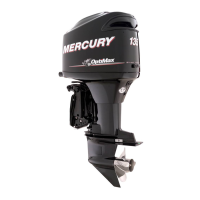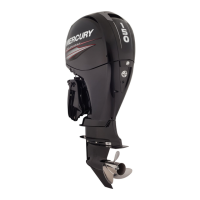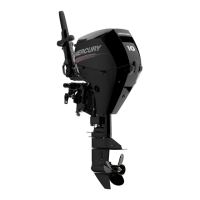10
90-10225R30
GB
gob39
a
c
b
d
Courtesy of ABYC
2
ob
GENERAL INFORMATION
obi3
EXHAUST EMISSIONS
Poor Ventilation
Under certain running and/or wind conditions, permanently enclosed or canvas
enclosed cabins or cockpits with insufficient ventilation may draw in carbon
monoxide. Install one or more carbon monoxide detectors in your boat.
Although the occurrence is rare, on a very calm day, swimmers and passengers
in an unclosed area of a stationary boat that contains or is near a running engine
may be exposed to a hazardous level of carbon monoxide.
2 Examples of Poor Ventilation:
While boat is stationary
a. Running the engine when the boat is moored in a confined space.
b. Mooring close to another boat that has its engine running.
While boat is moving
c. Running the boat with the trim angle of the bow too high.
d. Running the boat with no forward hatches open (station wagon effect).
obj2
SELECTING ACCESSORIES FOR YOUR OUTBOARD
Genuine Mercury Marine Quicksilver Accessories have been specifically
designed and tested for your outboard. These accessories are available from
Mercury Marine dealers.
Some accessories not manufactured or sold by Mercury Marine are not designed
to be safely used with your outboard or outboard operating system. Acquire and
read the installation, operation, and maintenance manuals for all your selected
accessories.
WARNING
Check with your dealer before installation of accessories. The misuse of
acceptable accessories or the use of unacceptable accessories can re-
sult in serious injury, death, or product failure.
obk1
SAFE BOATING SUGGESTIONS
In order to safely enjoy the waterways, familiarize yourself with local and other
governmental boating regulations and restrictions, and consider the following
suggestions.
Use flotation devices. Have an approved personal flotation device of suitable
size for each person aboard (it is the law) and have it readily accessible.
Do not overload your boat. Most boats are rated and certified for maximum load
(weight) capacities (refer to your boat capacity plate). If in doubt, contact your
dealer or the boats manufacturer.
Perform safety checks and required maintenance. Follow a regular schedule
and ensure that all repairs are properly made.
Know and obey all nautical rules and laws of the waterways. Boat operators
should complete a boating safety course. Courses are offered in the U.S.A. by (1)
The U.S. Coast Guard Auxiliary, (2) The Power Squadron, (3) The Red Cross and
(4) your state boating law enforcement agency. Inquiries may be made to the
Boating Hot-line, 1-800-368-5647 or the Boat U.S. Foundation information number
1-800-336-BOAT.
Make sure everyone in the boat is properly seated. Don’t allow anyone to sit
or ride on any part of the boat that was not intended for such use. This includes
backs of seats, gunwales, transom, bow, decks, raised fishing seats, any rotating
fishing seat; anywhere that sudden unexpected acceleration, sudden stopping,
unexpected loss of boat control or sudden boat movement could cause a person
to be thrown overboard or into the boat.
Never be under the influence of alcohol or drugs while boating (it is the law).
They impair your judgment and greatly reduce your ability to react quickly.
Prepare other boat operators. Instruct at least one person on board in the basics
of starting and operating the outboard and boat handling in case the driver
becomes disabled or falls overboard.
Passenger boarding. Stop the engine whenever passengers are boarding,
unloading or are near the back (stern) of the boat. Just shifting the outboard into
neutral is not sufficient.
Be alert. The operator of the boat is responsible by law to “maintain a proper
lookout by sight (and hearing).” The operator must have an unobstructed view
particularly to the front. No passengers, load, or fishing seats should block the
operators view when operating the boat above idle speed.
Never drive your boat directly behind a water skier in case the skier falls. As
an example, your boat traveling at 25 miles per hour (40 km/hr) in 5 seconds will
overtake a fallen skier who was 200 feet (61m) in front of you.
Watch fallen skiers. When using your boat for water skiing or similar activities,
always keep a fallen or down skier on the operator’s side of the boat while returning
to attend the skier. The operator should always have the down skier in sight and
never back up to the skier or anyone in the water.
Report accidents. Boat operators are required by law to file a Boating Accident
Report with their state boating law enforcement agency when their boat is involved
in certain boating accidents. A boating accident must be reported if (1) there is loss
of life or probable loss of life, (2) there is personal injury requiring medical treatment
beyond first aid, (3) there is damage to boats or other property where the damage
value exceeds $500.00 or (4) there is complete loss of the boat. Seek further
assistance from local law enforcement.
gob21
19XX
XX
OGXXXXXX
XXXX
a
c
b
d
e
obl9
RECORDING SERIAL NUMBER
It is important to record this number for future reference. The serial number is
located on the outboard as shown.3
a. Serial Number
b. Model Year
c. Model Designation
d. Year Manufactured
e. Certified Europe Insignia (as Applicable)
obm66
SPECIFICATIONS
Models 115
Horsepower 115
Kilowatts 85.8
Full Throttle RPM Range 5000-6000 RPM
* Idle Speed in Neutral Gear 750 ± 50 RPM
Number of Cylinders 4
Piston Displacement 106.2 cid (1741cc)
Cylinder Bore 3.110 in. (79 mm)
Stroke 3.496 in. (88.8 mm)
Valve Clearance (Cold)
Intake Valve
Exhaust Valve
0.007-0.009 in. (0.17-0.23mm)
0.012-0.014 in. (0.31-0.34mm)
Recommended Spark Plug NGK LFR6A-11
Spark Plug Gap 0.043 in. (1.1mm)
Gear Ratio 2.07:1
Recommended Gasoline Refer to Fuel Section
Recommended Oil Refer to Fuel Section
Gear Case Lubricant Capacity 24.0 fl oz. (710 mL)
Engine Oil Capacity 5 Quarts (5 Liter)
Battery Rating
Operation Above 32° F (0°C)
Operation Below 32° F (0°C)
Ampere Hours (Ah)
465 Marine Cranking Amps (MCA)
or 350 Cold Cranking Amps (CCA)
1000 Marine Cranking Amps (MCA)
or 750 Cold Cranking Amps (CCA)
70-100
* = With engine fully “warmed up”

